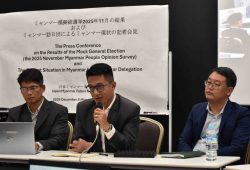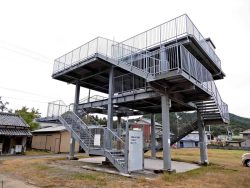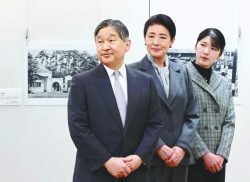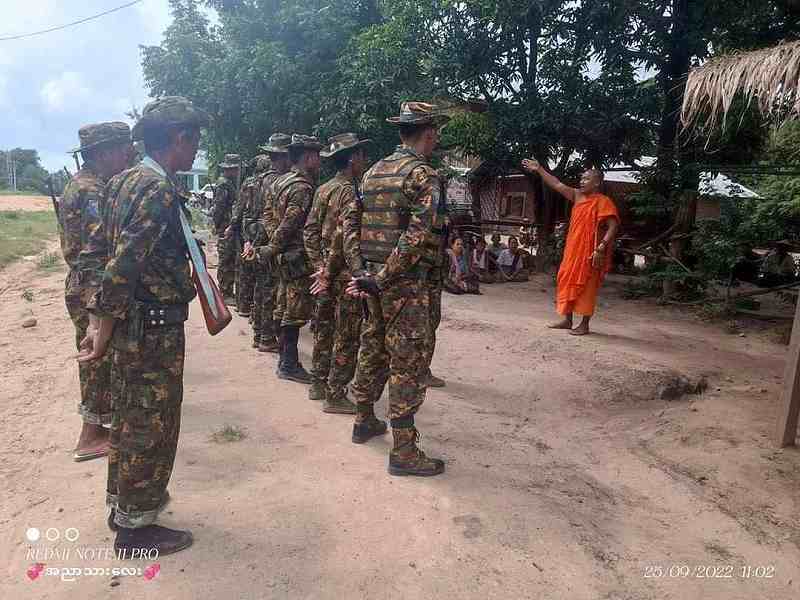
An undated handout picture shows Wathawa, a pro-junta monk, addressing crowds.
16:07 JST, December 17, 2022
In a monastery in central Myanmar, a Buddhist monk, Wathawa, rallies his militia with a cry: “What’s our spirit like?”
“The spirit of iron!” shout a group of rifle-bearing men, loyalists of the military junta that seized power last year, now fighting to crush fledgling pro-democracy groups.
The scene, from a video posted online by army-linked media, would have seemed unimaginable to previous generations in the overwhelmingly Buddhist nation. Now, it underscores the close alliance the military has forged with the Buddhist hierarchy.
Myanmar’s Buddhist clergy previously sought to topple successive military dictatorships that kept citizens impoverished and isolated. Monks were part of the 1988 uprising that brought Nobel laureate Aung San Suu Kyi to prominence. Thousands thronged the streets during 2007 anti-government protests known as the Saffron Revolution.
Many are now supporters of the new junta.
The change reflects a years-long effort by the military to build stronger ties with Buddhist leaders by lavishing them with gifts and cultivating a shared ultranationalist and often Islamophobic vision, according to 11 people familiar with the monastic system, including three current or former monks and four researchers. Three spoke on the condition of anonymity for fear of military reprisals.
In recent years, ultranationalist monks incited violence against Muslims in Myanmar, including riots that killed 25 people in 2013 and army-led attacks against the Rohingya minority.
As the new junta suppresses opponents, religious leaders have been largely absent from the widespread resistance to last year’s army coup, which ended the decade-long democratic experiment that brought Suu Kyi to power.
Some monks, like Wathawa, who claims to have thousands of armed followers, are serving to rally militia fighters against armed pro-democracy groups that emerged after the military crushed peaceful protests with deadly force.
Troops have burned more than 100 villages and killed civilians in attacks the United Nations has called probable war crimes and crimes against humanity.
In public comments and state media broadcasts as recently as November, the military has acknowledged forming militias in some villages “based on their demands,” but has denied arming monks. It denies targeting civilians, saying its operations are against “terrorists.” A military spokesman did not respond to Reuters’ requests for comment about its relationship with the militia.
Engineering a separation
Wathawa and other ultranationalist monks have appeared marching alongside soldiers, carrying weapons, in images published by local media and verified through open-source investigation by U.K.-based monitoring group Myanmar Witness, which also geolocated militia training happening at his monastery in Kantbalu, in central Myanmar.
Wathawa, who like many monks goes by one name, confirmed his leadership of militia fighters in a phone interview with Reuters, calling resistance forces “a bunch of thugs.”
He said he founded the militia, which operates out of Kantbalu, to stabilize the region and protect locals. Accusing resistance forces of killing civilians, including monks, and “doing nothing but destructive things,” he said, “I am doing what I can. It is not wrong that I founded the militia.”
Pro-democracy forces acknowledge killing suspected military informants, but deny targeting civilians.
“There is no guarantee for our lives,” Wathawa said. “Even though I’m talking to you today, tomorrow might be the day I die.”
Not all of the country’s several hundred thousand monks support the junta. Almost every week, dozens gather to protest in monasteries in the Buddhist heartland of Mandalay, despite surveillance and crackdowns. Several disrobed and joined armed resistance groups.
Htavara, a monk who led Saffron Revolution protests and now lives in exile in Norway, said monks who participated in the violence against the junta’s opponents were violating the first precept of their religion.
“Killing living things is an unforgivable crime in Buddhism,” he said.
The country’s top Buddhist authority, known as the Ma Ha Na, has been silent on the crisis. Its chairman met with army chief Min Aung Hlaing shortly after the coup. The organization did not respond to a request for comment about militant monks and whether it supported the junta.
Among the venerated religious leaders loudly backing the junta is Sitagu, a once beloved figure who took part in the 1988 uprising. Now he is a regular companion of Min Aung Hlaing, whom he calls “benevolent king,” flying with him to Russia. During the military’s 2017 expulsion of the Rohingya, he justified the killing of non-Buddhists in a sermon that asserted their lives were worthless.
In one recent video from a trip to Russia — President Vladimir Putin is one of the junta leader’s few remaining allies — Sitagu can be seen beating drums alongside Russian monks and chanting, “Peace and glory to the great country of Russia.”
In a message to Reuters, Sitagu said he was “deeply saddened by the current situation in Myanmar, especially by the difficulties that people are facing.” He said he did not favor “any parties” and that it was his desire that “the people and the nation prosper.”
Russian Foreign Minister Sergei Lavrov, on a visit to Myanmar in August, said he backed the military’s attempts to “stabilize” the country. In an emailed response to Reuters, Russia’s embassy in Myanmar provided details of Sitagu’s trip and said Russia-Myanmar ties were “deepening in many directions” including trade, investment, education and energy. “This will benefit the peoples of the two countries in the long run,” it said.
The displays of bellicosity by some monks have led to a rare backlash in Myanmar. Online memes and expletive-filled posts against military-supporting monks are now common.
Ten people interviewed by Reuters in cities including Yangon and Mandalay, among them a grocery store owner and a director of commercials, said they had changed the way they donated to monks. Some were scrutinizing monks more closely to avoid aiding those that support the junta, while others had eschewed the centuries-old tradition completely.
“It is the start of the change,” said Naung Naung, a student from the central Magwe region, referring to the increasing willingness of Myanmar residents to question the religious establishment.
Until recently, everyone in the country recognized “dictators as dictators,” said one monk from Kantbalu, the same hometown as Wathawa. “People and monks were on the same side.”
In response, he said, the military organized a “separation,” in part by cultivating patronage relationships with monks, particularly the most influential.
Furthermore, the military instilled hatred against other religions, he said.
Masters and followers
After the monks joined protests, the military started offering special privileges to religious leaders, through a patronage practice known as “masters and followers,” said Nickey Diamond, a Burmese academic from Mandalay who has written about religion and nationalism in Myanmar. His account was echoed by the monk from Kantbalu and another academic, who spoke on the condition of anonymity for fear of retribution.
Myanmar monks teach laypeople who in turn provide them with essentials such as food and clothing. But monkhoods that built strong relationships with the military were awarded gifts like land, cars, and monasteries, said Diamond, without identifying the beneficiaries.
“When the Saffron Revolution happened, the military feared it, and attempted to divide the force,” he said, referring to the regime’s opponents.
Meanwhile, a virulent strain of Buddhist nationalism was being propagated within the country’s monasteries, its origins traceable to an official within the previous military dictatorship who wrote and distributed xenophobic, anti-Muslim tracts.
The books, which told sensationalized stories about misdeeds of Muslims and the marriage of Muslim men to Buddhist women, “brainwashed monks to be Islamophobic,” said the monk from Kantbalu, whose account of exposure to anti-Muslim texts echoed those of several others interviewed by Reuters.
“My life has been spent in prestigious monastic Buddhist centers in Myanmar,” he said. “Since I was 14 years old, I read books that condemned other religions.”
In the mid-2010s, an ultranationalist movement, Ma Ba Tha, advocated boycotts of Muslim-owned businesses, called for discriminatory race and religion laws, and was implicated in waves of deadly violence against Muslims. At the time, the group denied inciting violence and said it was only against Islamic extremists.
‘Many militia’
Min Aung Hlaing, the general who overthrew Suu Kyi in February 2021, has tried to cultivate an image as a protector of the nation’s majority Theravada Buddhist religion, in the style of a long line of warrior-kings.
The day before he seized power, he placed the first stone in a seated Buddha statue he says will be the world’s largest. He is also seeking donations for the world’s largest Buddhist pagoda “to show the world that Theravada Buddhism is shining brightly in Myanmar,” according to state media.
State news broadcasts displaying military support for Buddhism increased fourfold in the nine months immediately after the coup, according to an analysis by the United States Institute of Peace, a U.S.-funded institute that analyzes conflicts overseas. Min Aung Hlaing has sought to justify the coup by claiming Suu Kyi failed to protect “race and religion.”
Despite standing beside the army as it oversaw the deadly 2017 purge of 730,000 ethnic Rohingya, the Suu Kyi government later attempted to rein in ultranationalist Ma Ba Tha monks who publicly endorsed the violence. Ma Ba Tha was disbanded and Wirathu, a monk who toured the country inciting hatred of Muslims, was jailed for sedition.
Since last year’s coup, Suu Kyi and most of her government have been jailed on multiple charges, while Ma Ba Tha monks including Wirathu have been freed. The junta has not said why they were released. Wirathu’s spokesperson did not respond to requests for comment.
In videos posted online, Wathawa, known locally as “Ma Ba Tha monk” because of his ties to the group, praises Min Aung Hlaing as the “greatest leader” to rule Myanmar. He says he has personally founded “many militia” to fight pro-democracy groups and has more than 4,000 followers.
Taiga, a spokesman for the Taze People’s Defence Force, a resistance group, who goes by one name, said the figure was lower and that Wathawa’s group forcibly recruited from villages. Reuters was not able to independently verify the recruiting tactics or the size of the militia’s membership.
He said his group would be prepared to kill monks if they were in battle with the junta, “There are good and bad monks … We consider an ally of an enemy to be an enemy, whether he is a monk or not.”
In one video, Wathawa can be seen beating villagers for supporting resistance fighters.
“It will never be possible for them to win over the military in the near future, or ever,” Wathawa told Reuters by phone.
Questioned further, the phone line went dead, and he did not answer subsequent calls. He did not respond to questions about the beatings.
State media broadcasts have shown military commanders showering Wathawa and his militia with cash and food donations.
In November, junta media announced the military had honored Wirathu with an award for “outstanding performance” and Wathawa a prize for “social excellence, first grade.”
"World" POPULAR ARTICLE
-
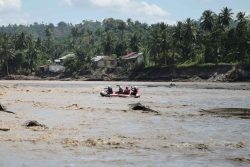
8 Japanese Nationals Stranded on Indonesia’s Sumatra Island
-

U.S. Senate Resolution Backs Japan, Condemns China’s Pressure
-
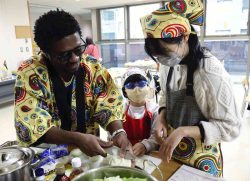
Mozambican Cooking Class Held in Matsuyama, Ehime Pref.; Participants Don Aprons, Bandanas Made from Traditional Mozambique Fabric
-

China to Impose Sanctions on Shigeru Iwasaki, Former Head of Japan’s Self-Defense Forces, Who Serves as Adviser to Taiwan’s Executive Branch
-
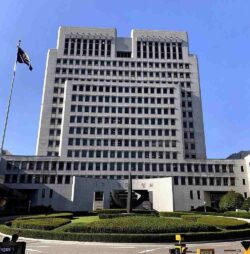
South Korea’s Top Court Dismisses Nippon Steel Appeal in Lawsuit over Requisitioned Worker
JN ACCESS RANKING
-

Tokyo Economic Security Forum to Hold Inaugural Meeting Amid Tense Global Environment
-

Keidanren Chairman Yoshinobu Tsutsui Visits Kashiwazaki-Kariwa Nuclear Power Plant; Inspects New Emergency Safety System
-

Imports of Rare Earths from China Facing Delays, May Be Caused by Deterioration of Japan-China Relations
-

University of Tokyo Professor Discusses Japanese Economic Security in Interview Ahead of Forum
-

Japan Pulls out of Vietnam Nuclear Project, Complicating Hanoi’s Power Plans



